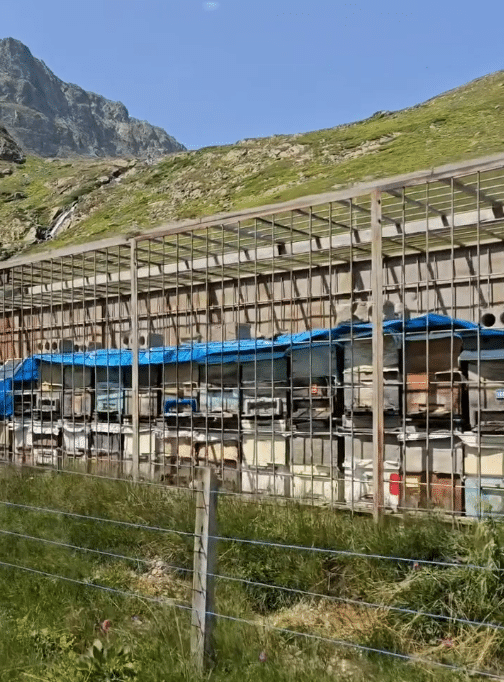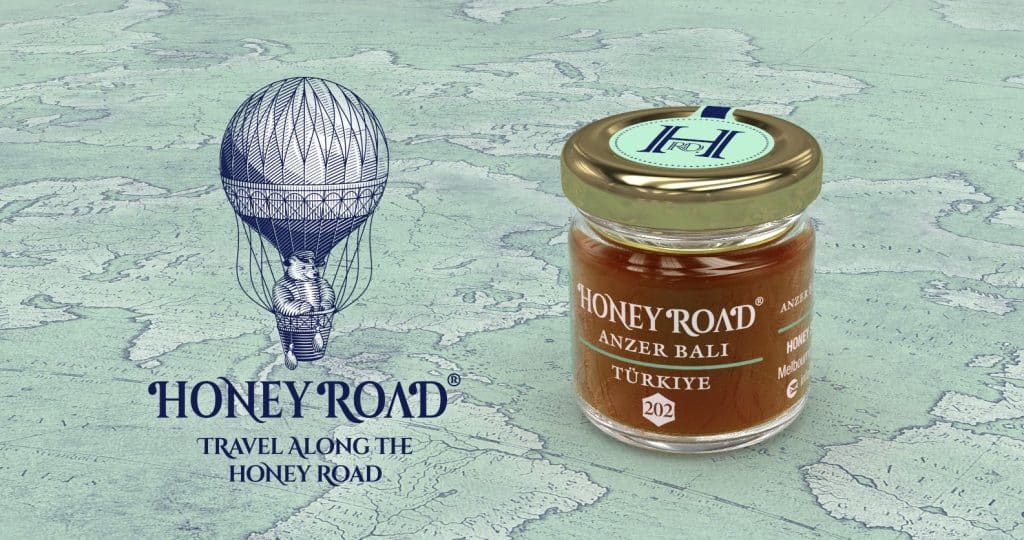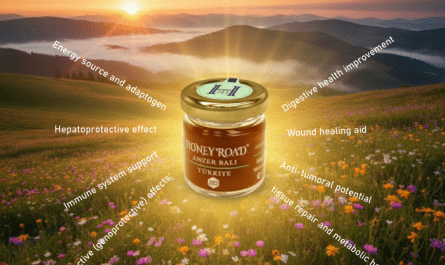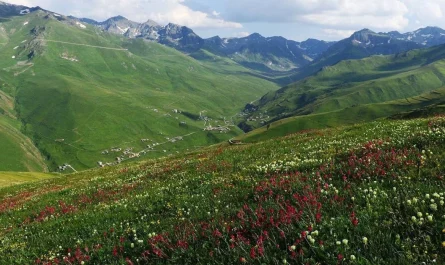Characteristics of Anzer honey
Anzer honey, a premium Turkish product, is defined by its pristine source and exceptional chemical profile. Its characteristics include a color ranging from light amber to deep golden-brown, a creamy texture, and a distinctly herbal aroma. Chemically, it stands out with very high levels of bioactive phenolics and antioxidants—such as pinocembrin, hesperidin, and chrysin—which confer strong anti-inflammatory and anti-tumoral properties, surpassing many other floral honeys.
Anzer honey is no ordinary honey. Bees collect nectar from over 500 endemic plant species from a pristine, industrially untouched environment, giving rise to a unique, premium product with remarkable characteristics. That’s pretty special!
Color: from light amber to deep golden-brown hues, depending on seasonal flora.
Texture: a creamy texture with a natural tendency to crystallize after 3-6 months in a fine-grained, uniform way.
Aroma: distinctly herbal, reflecting the mountain flora.
Taste: richly floral with a complex sweetness and subtle earthy undertones.
Nutritional and Chemical Profile of Anzer honey
The bioactive profile of Anzer honey is indeed exceptional. There have been lots of studies because this honey intrigued scientists and provoked them to discover its valuable components. Here they are:
Antioxidants & Phenolics: High in powerful antioxidant compounds such as pinocembrin, hesperidin, chrysin, caffeic acid phenyl ester (CAPE), gallic acid, and p-coumaric acid. They all support anti-inflammatory, antimicrobial, and anti-tumoral functions. (Malkoç et al., 2019)
Flavonoids: Rich in flavonoids like myricetin, luteolin, rutin, and resveratrol, these enhance immune system function.
Vitamins & Minerals: Contains vital B-complex vitamins (B1, B2, B3, B5, B6) and minerals including potassium, calcium, magnesium, iron, and zinc, all contributing to energy metabolism, bone and nerve health, and immune support (TryAladdin, 2025).
Sugars Dominated by natural fructose and glucose with minimal sucrose. (GIDA Journal, 2019).
Enzymes: Enzymes like glucose oxidase, diastase, and invertase remain intact due to no heat treatment, contributing to antibacterial properties and overall health benefits.
But aren't these indicators common for all honeys?
Well, they are, but in Anzer honey some of these characteristics are different. Here’s a comparison with chestnut honey and regular polyfloral honey, both from Turkey. Notice that Anzer honey has very high levels of bioactive phenolics and antioxidants, higher than polyfloral honeys and in some measures even comparable to chestnut honey.
Chestnut honey is mainly produced in the Black Sea region of Turkey, including places like Şile near Istanbul, where it is a geographically indicated product. This honey is known for its high mineral content, dark color, and characteristic bitter taste. The Turkish Black Sea region is recognized for high-quality chestnut honey production that complies with traditional methods and organic standards.
Polyfloral honey in Turkey typically comes from varied floral sources across different regions, including the Black Sea, Anatolia, Aegean, and Mediterranean areas, reflecting diverse local flora and ecosystems.
| Component | Anzer Honey | Chestnut Honey | Polyfloral Honey | Unit | Source |
|---|---|---|---|---|---|
| Total Phenolic Content | 269.2 mg GAE/kg (26.92 mg/100g) | 316 mg GAE/kg | ~150-200 mg GAE/kg | mg GAE/kg | Malkoç et al. 2019, Others |
| Total Flavonoid Content | 27.9 mg QE/100g | Higher than Anzer (exact varies) | Lower than chestnut and Anzer | mg QE/100g | Malkoç et al. 2019 |
| Antioxidant Activity (FRAP) | 110.11 μmol Trolox/100g | Higher (exact varies) | Moderate | μmol Trolox/100g | Malkoç et al. 2019 |
| Moisture Content | 16 - 21 % | 17 - 19 % | 16 - 20 % | % | GIDA Journal 2019, others |
| Electrical Conductivity | 0.26 - 0.79 mS/cm | Higher than Anzer (~1.2-2.2 mS/cm) | Lower than chestnut, higher than Acacia | mS/cm | GIDA Journal 2019 |
| pH | 3.74 - 4.08 | 4.0 - 4.5 | 3.9 - 4.2 | — | GIDA Journal 2019 |
| Total Acidity | 9.65 - 27.96 meq/kg | 14 - 29 meq/kg | Lower than chestnut, varies | meq/kg | GIDA Journal 2019 |
| Fructose Content | 30.41 - 40.98 % | Similar range | Similar range | % | GIDA Journal 2019 |
| Glucose Content | 17.23 - 36.47 % | Similar range | Similar range | % | GIDA Journal 2019 |
| Sucrose Content | Nearly 0 | Very low | Very low | % | GIDA Journal 2019 |
| Potassium (K) | 1265 - 5888 mg/kg | 800 - 2600 mg/kg | Variable | mg/kg | Mineral study |
| Calcium (Ca) | 300 - 854 mg/kg | 400 - 1500 mg/kg | Variable | mg/kg | Mineral study |
| Magnesium (Mg) | 41 - 90 mg/kg | 17 - 55 mg/kg | Variable | mg/kg | Mineral study |
| Iron (Fe) | Higher content detected | Moderate | Lower | mg/kg | Mineral study |
Particularities of producing Anzer honey
- Beekeeping methods used for Anzer honey are highly specialized and closely regulated to protect the purity, uniqueness, and ecological value of this celebrated Turkish honey:
- Exclusivity: Only beehives that are registered by local cooperatives are permitted in the Anzer Plateau. Outside apiaries are strictly banned to prevent cross-contamination and protect the endemic flora.
- Pristine, High-altitude Environment: Beekeeping occurs at altitudes of 2,500-3,000 meters. Bees forage among more than 500 wildflower species, 80–90 of which are endemic—many not found elsewhere in the world.
- Caucasian Bees: Local beekeepers prefer pure Caucasian or Caucasian hybrid bees (Apis mellifera caucasia), considered superior for collecting nectar and producing high-quality honey in the region’s cold, mountainous climate. They are more resistant to cold temperatures and less aggressive.
- Ecological Protection: There is no industrialization in the area. Grazing livestock are only allowed in limited areas during certain periods to preserve wildflower habitats.
- Seasonal Migration and Hive Placement: Village beekeepers migrate to the plateau with their hives from early May, positioning them for optimal access to the unique flower tapestry. Honey harvesting takes place in a short window between August 15–20, when climatic conditions permit.
- Cold Extraction/“Milking”: Anzer honey is traditionally harvested using a cold extraction process called “milking,” in which honey is gently removed from the frames to avoid heat or mechanical stress. This preserves beneficial enzymes, nutritional qualities, and floral aromas.
- Limited Honeycomb Production: Because floral nectar and climate yield limited quantities, Anzer honey is rarely produced with honeycomb; most harvest is liquid honey. Yields per hive are low (between 1–5 kg per season). However, good surprises do happen. Did you hear about the tripled production from 2025?
- Geographical Indication Certification: Every genuine jar carries a Geographical Indication (GI) Seal, certifying origin, authenticity, and adherence to local traditional beekeeping rules.
- Protection Against Animals: To safeguard against bears (common in the mountains), hives are often placed inside special steel cages—a blend of ancient tradition and practical adaptation. (see image below. Courtesy of HoneyRoad.com)

Does Anzer honey have any therapeutic indications?
Anzer honey appears in several scientific studies that highlight its therapeutic indications, particularly through its antioxidant, anti-inflammatory, antibacterial, and genoprotective properties.
There are studies showing its therapeutic value, even comparing it with Manuka honey (in wound healing). You can find them in the articol: Anzer honey—a functional food! Does it mean it has therapeutic value?




